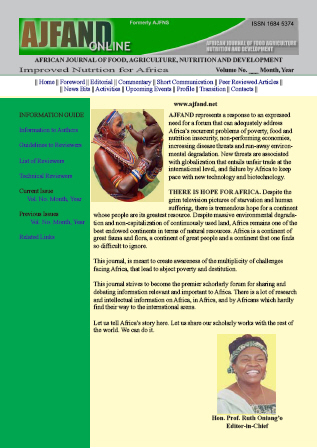
|
African Journal of Food, Agriculture, Nutrition and Development
Rural Outreach Program
ISSN: 1684-5358
EISSN: 1684-5358
Vol. 10, No. 5, 2010, pp. 2587-2600
|
 Bioline Code: nd10051
Bioline Code: nd10051
Full paper language: English
Document type: Research Article
Document available free of charge
|
|
|
African Journal of Food, Agriculture, Nutrition and Development, Vol. 10, No. 5, 2010, pp. 2587-2600
| en |
Effects of vegetable drying techniques on nutrient content: A case study of south-western Uganda
Kiremire, B.T.; Musinguzi, E.; Kikafunda, J.K. & Lukwago, F.B.
Abstract
Micronutrient deficiencies are high in Uganda. To the rural poor, the most compelling and long- term strategy to address this problem is dietary diversity. However, postharvest losses and seasonal variability within key foods still hamper the community based efforts to supply local food sources throughout the year. Vegetables are important in most of the daily diets and can be used to alleviate most of the micronutrient deficiencies. Vegetables are only available during the rainy season in rural areas. Therefore, it is necessary to preserve them and use them during the dry season when they are scarce. The objective of this study was to establish food preservation methods that could easily be adopted for preservation of vegetables in order to even out the imbalance of supplies between the rainy and the dry season. In order to achieve the objective, first, a survey was carried out in South Western Uganda, to identify the traditional methods of preservation of food plants. Then, the traditional methods were compared with other methods that can be used for drying vegetables, with respect to retention of nutrients after drying to determine the best method applicable to a rural setting. Sun drying was identified as the only traditional method of preserving foodstuffs in Rukungiri district. The method was cited by all households (n=116) in the drying of grains legumes and cereals such as maize, millet and sorghum. Apart from sun drying, two other methods are applicable to the rural setting; namely oven drying and solar drying. The effects of sun drying, solar drying and oven drying on the nutrient composition of selected vegetables were assessed by proximate analyses and compared with the nutrient content of the fresh vegetables. The results showed that some nutrients were lost during the drying process but in general, the nutrient content remained high. With respect to retention of the nutrient content in vegetables, solar drying was found to be the best of the three methods. Based on this study, solar drying is recommended as a method for vegetable preservation.
Keywords
Vegetables, Preservation, Drying, Nutrients, Uganda
|
| |
© Copyright 2010 African Journal of Food Agriculture, Nutrition and Development.
Alternative site location: http://www.ajfand.net/
|
|
